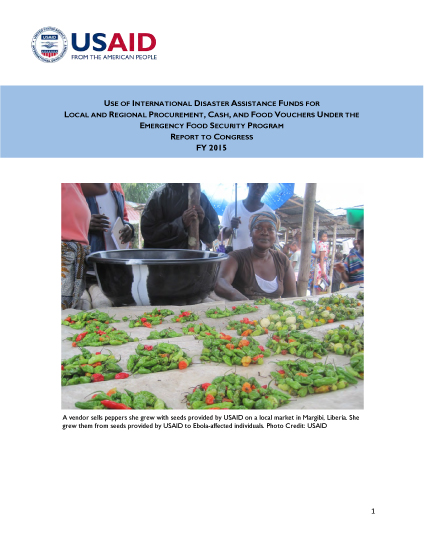This report is submitted pursuant to the reporting requirement in the explanatory statement accompanying the FY 2015 Consolidated and Further Continuing Appropriations Act (P.L. 113-235). This report describes how USAID used FY 2015 International Disaster Assistance (IDA) funding to address food insecurity in emergency situations through market- based mechanisms such as local and regional procurement (LRP), cash transfers for food, and food vouchers as part of the Emergency Food Security Program (EFSP).
Background
USAID, through the Office of Food for Peace, the United States Government’s lead office on addressing international food security emergencies, has implemented the EFSP program since 2010. In addition to in-kind food assistance, which continues to play a critical role, Food for Peace uses local and regional procurement, cash transfers for food, and food vouchers as important tools for providing food assistance in emergency settings. Studies by federal agencies and independent experts have demonstrated these tools can improve the efficiency and effectiveness of providing life-saving assistance. Market-based approaches can diversify diets and have a positive impact on nutrition while also ensuring beneficiaries are afforded the dignity of having access to culturally appropriate foods that they know how to prepare.
A USAID analysis of Fiscal Year 2013 data for local and regional procurement (LRP) programs found savings on commodity and freight costs of approximately 30 percent when compared to in-kind food assistance from the United States. For food voucher and cash transfer programs, where cost effectiveness was a primary goal, savings ranged from 18 to 40 percent compared to the commodity and freight costs of U.S. in-kind food assistance. These findings are consistent with the previous year’s findings and academic studies on cost-effectiveness. In other cases, USAID partners implemented food voucher and cash transfer programs where market conditions, access, and program objectives were the primary drivers (e.g. improve dietary diversity, reduce malnutrition, mitigate family asset depletion).
While in-kind assistance remains a critical tool for U.S. food assistance, interventions such as these can promote market recovery, strengthen and expand market linkages, and stimulate an appropriate production response among developing country farmers. When strategically assessed to be the most effective intervention, LRP, cash transfers for food, and food vouchers provide an effective means for responding to food insecurity needs. A 2013 study found that, in most cases, vouchers and cash transfers have also been found to be a cost effective and efficient way of diversifying diets where local markets are functioning.








Comment
Make a general inquiry or suggest an improvement.